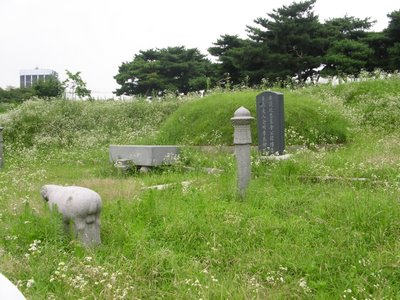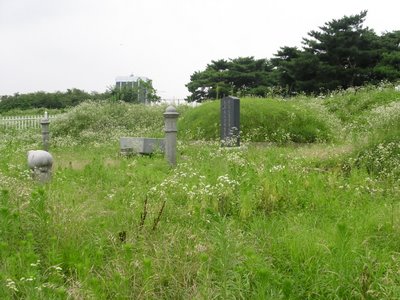山村訓長但知覓
The Sanchon Hunjang(usually clicking on the photos yields an enlarged version)
8/01/2006
On tombs and translations

The stone itself has a top, the main body and a base, like so many of its kin. And the body starts with a header in seal script (전서) over the top of a rather long main inscription in regular script (해서). For the seal-script impaired, the header says (right to left) "右議政諡忠憲 Discusser of Governance of the Right, Posthumously Named Ch'unghŏn."

In the background you can see a grave mound, so it is clear that the stone must have something to do with the indivual buried there.

There is also a descriptive sign that purports to explain everything in both Korean and English.

This is the memorial stone of Second State Councilor Kim Gu, and was erected in 1743.
Kim Gu's pen name was Ganbokjae and his posthumous title was Chungheongong. He received the highest score among all applicants on the civil service examination in 1682 and entered public service in the Office of the Inspector General and the Office of the Censor General. His advice on important matters there earned him the admiration of the people. He restored Prince Nosan's title of King Danjong and named his tomb Jangneung. He also contributed greatly to naming Queen Shin's tomb, Olleung.
This memorial consists of a square pedestal, a marble monument body, and a capstone. The capstone is embossed with various designs, such as dragons, phoenixes, roof tiles, the herb of eternal youth and bats. Such carvings are not found on other memorial stones. The inscription was composed by First State Councilor Yi Uihyeon and the calligraphy was done by Kim Gu's second son-in-law, First State Councillor Seo Myeonggyun. The block characters of the monument's title were written by Second State Councilor Yu Cheokgi.
To the north of this monument, in front of the tomb, stand a small tombstone, a pair of octagonal stone posts, and two stone sheep. These are also important for the study of tombs in the early 18th century.이 비는 조선 숙정 때 우의정을 역임한 김구의 신도비로서, 영조 19년 (1743)에 걸립되었다.
김구의 자는 사궁, 호는 관복재이며, 시호는 충헌이다. 숙종8년(1682)에 춘당대 문과에 장원급제하였으며, 사헌부와 사간원에 출입하면서 사무에 대한 진언으로 일반의 찬탄을 받았다. 그리고 노산군의 단종복위와 장릉의 능호를 추복하였으며, 중종비 단경왕후 신씨의 묘를 온릉으로 추복하는데 크게 기여하였다.
이 비는 사각형 받침돌 위에 대리석으로 된 비몸이 있으며, 그 위에 지붕 돌이 얹혀져 있다. 지붕 돌인 옥개석에 용봉황,암막새, 수막새, 불로초, 박쥐, 그림무늬 등의 문양이 다채롭게 조각되어 있는 것은 여느 신도비에서는 잘 찾아볼 수 없는 특이한 것이다. 비문은 영의정을 지낸 이의헌이 지었고, 글씨는 김구의 둘째 사위인 좌의정 서명균이 썼다. 비의 제목글씨인 전액은 영의정을 지낸 유척기가 썼다.
이 비의 북쪽에 있는 그의 무덤 앞에는 돌비석과 돌기중, 석양 두마리가 배치되어 있다. 이것들도18세기 전반기의 무덤 석조물로서 묘재를 확인하는데 중요한 자료가 된다.
Maybe I'm just picky, but these explanations always seem lackluster. And I think the reason is that the translation into English is executed by someone whose purpose is to render a Korean text with precise accuracy rather than someone who is interested in communicating a message. (Whether the Korean original is useful information is another can of worms that I won't get into...) Maybe the English version turns out like this is because there was no audience defined. It is surely difficult to write before you know the level of specialized knowledge you can assume your audience has. To understand what the English on this sign is saying, one would seem to need a degree in Korean studies. But in that case, why bother with the English? The target audience could just read the Korean. Whether the Korean is well done or not, the English translation would seem misguided. It raises more questions than it answers:
- Kim Gu? Is this that famous independence activist with the funky specs, 백범 김구?
☞ Nope, sorry. That's another Kim Ku (1876 - 1949) - Why are you writing more about the stone than about the person it was erected in honor of?
- If this is a memorial stone and Mr. Kim's grave is there, why didn't you bother to list his dates of birth and death?
☞ Kim Ku (1649 - 1704) - Under what circumstances are memorial stones erected? Is this a common thing?
☞ These memorial stones are called 신도비, where 비 means memorial tablet ("비석") and 신도 refers to the road of the spirit (of the deceased). They are erected on the road to the graves of high government officials (during the Yi Dynasty, they were limited to the highest 4 grades of officials: 종2품, 정2품, 종1품, 정1품) and kings and describe the accomplishments of the man. Generally they are erected facing south and placed to the south of the grave. - What is a second state councillor? And other questions about the structure of the Yi Dynasty government (what is the Office of the Censor General, the Office of the Inspector General, what do they censor and inspect, are these prestigious assignments, are these the only positions he held, etc.)
☞ In the Yi Dynasty government, there were three state councilors who formed the upper eschelon of officials in the government under the king. They were 영의정 "Chief State Councilor," 좌의정 "Second (즉 "of the left") State Councilor," and 우의정 "Third (즉 "of the right) State Councilor." Notice that left is higher than right, and that our translator above mis-translated 우의정 as second councilor, when it is actually third. The answers to all the other questions about the Korean governmental structure probably do constitute a good portion of the coursework for a degree in Korean studies. ^^ - Why did he use a pen name? Was he an author? What is up with these names given after death? Is that a common thing?
☞ Naming in traditional Korea was a complicated thing. Suffice it to say that it was very common for people to take a 호 號 as a sort of nickname. After-death names were very formulaic things (so you see the same characters and even the same names used over and over), but since they are bestowed by the king in recognition of the virtues of the deceased, it's a big deal and you had to be pretty exceptional to get one. The Korean also mentions his 자 was Sagung, but it's just more extraneous information. - Why is it so special that he placed first in the civil service exam? What was the system for becoming a government official? Why would he want to become a government official in the first place?
☞ Let's just say that the good jobs and the prestige were all with the government, and the two level government exam were the key to get in. Sort of like the Foreign Service Written and Oral Exams. And, like the Foreign Service Exam, a lot of trivia not necessarily related to the actual tasks involved in the job are tested. In the Korean case, it was a lot of detail about the Confucian classics and their orthodox interpretation, as well as one's ability to compose a poem in the traditional Chinese genres - You say that he worked on important matters, but the only things you mention are that he restored some dead guy's name and "contributed greatly" in the naming of some queen's tomb. Are these matters really that important?
☞ The dead guy was King Tanjong who was demoted to "prince," exhiled to 영월 and then assassinated by his uncle who took over the throne for himself. So the question of his legitimacy also affects the legitimacy of the dynasty. This is certainly something, but according to 지식 on Naver, Kim Ku's greatest accomplishment was working to ease some of the conflict between the factions in the government who were bickering night and day. - What are dragons, phoenixes, bats and the like symbolic of that they would be carved into the capstone of this monument?
☞ The others are auspicious mythical beasts. Bats are auspicious symbols because their name 복 蝠 sounds like "福 복 good fortune." Usually the capstones are pretty bland affairs with some rooftile inspired design (1, 2, 3), so to have all of these symbols carved is somewhat unusual. - Since you've framed this as a discussion about an inscribed monument stone, and you go on and on about who wrote which parts of the inscription, are you ever going to spill the beans on what the inscription actually says?
☞ I don't even want to think about how that translation would come out.
Moving on... Everything promised on the information sign can be seen at the tomb. The burial mound itself has been allowed to descend into a near criminal state of overgrowth. Not a good thing at a Korean grave.

The grave stone itself says: 右議政 Discusser of Governance of the Right1, 忠憲 Ch'unghŏn2 金公 Prince Kim3, 諱 tabooed word4, 構 Gu5 ['s6] 墓 grave / 貞敬婦人 Upright and Respected Lady7 全州李氏 of the Yi clan of Chŏnju8 祔 is interred 左 on the left9.
☞Notes:
1 I.e. Third State Councillor
2 His after-death name
3 This is the common form of address: surname + prince
4 The given name of the deceased is not supposed to be used, so it is preceeded with this "tabooed word" marker.
5 His given name
6 Usually they have "之墓 the grave of..." This one omits the "之 of" for asthetic reasons, which means to keep the same number of words on the right and left sides of the inscription
7 정경부인 is the one of the Chosŏn period titles applied to the wives of men of high standing and was reserved for the wives of the higest officials in the government. Women of this level received treatment on a par with royal princesses (공주), princesses by concubine (옹주), the mother of the queen (부부인) and the wet-nurse of the king (봉보부인)
8 Family and clan affiliation were a big deal in Yi Dynasty Korea. Of all the people named Yi, there are many large groups, identified by the region where they settled: Kyŏngju, Chŏnju, Tŏksu, Yŏnan, Sŏngju, Sŏngsan, etc. Chŏnju Yi was the royal family of the Yi Dynasty
9 Wives are frequently interred with their husbands. Usually on the husband's left, but occasionally on the right. Additionally, sometimes there is a second mound for the wife and other times there is only a single mound, as here.

The grave site is laid out in traditional Korean fashion, with main grave mound with a stone offering table and some statues/pillars in front and a separate protective mound of earth winding its way in a c shape behind the main grave mound. I didn't check to see if it was truly facing south.
I agree that often the guide signs in English are patronizingly devoid of useful information. This is especially odd, considering that most English-speaking travellers who take the trouble to both (a) visit Korea and (b) actually go to historic sites, are probably especially interested in learning the background story.
On one occasion, however, I've visited a site (a historic park in Daegu) where, believe it or not, the English sign actually did give more information than the Korean sign. I was astounded and pleased!
<< Home
Archives
7월 2005 8월 2005 9월 2005 10월 2005 11월 2005 12월 2005 1월 2006 2월 2006 3월 2006 7월 2006 8월 2006 10월 2006 4월 2007 5월 2007 6월 2007 7월 2007 8월 2007 9월 2007 10월 2007 11월 2007 12월 2007 1월 2008 5월 2008 8월 2008
